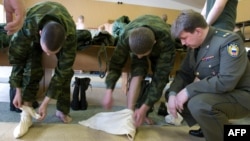Russia's new defense minister has ordered the army to do away with footwraps, still widely used by Russian servicemen as a substitute for socks.
Sergei Shoigu on January 14 instructed top army and Defense Ministry officials to phase out the accessory, also known as a foot cloth, from the armed forces.
Russian soldiers, he said, must "forget" about footwraps by the end of the year.
"One can still encounter such a thing as footwraps," Shoigu said. "The units, which we inspected.... Look, the approach toward our servicemen is really appalling. Just gauge the scope of this problem and solve it. I am asking you to release additional funds if needed and get rid of this notion as such in the armed forces once and for all."
Shoigu is not the first defense minister to declare war on footwraps, which Russian soldiers have been using for three centuries.
His predecessor, Anatoly Serdyukov, fired in November amid a procurement scandal, also sought to establish the universal use of socks in the army.
WATCH: A Russian soldier demonstrates the preferred method for applying a footwrap:
The influential Soldiers' Mothers organization, which has been lobbying for better conditions in Russia's armed forces, has also campaigned against this antiquated piece of clothing.
Footwraps, however, have stubbornly endured.
They were introduced into the Russian Army by Tsar Peter the Great, who first saw Dutch soldiers bandage their feet during a visit to the Netherlands.
Advocates say footwraps are more resistant than socks and offer better protection from the cold.
For many war veterans, the art of bandaging one's feet is an important hallmark of a real soldier.
But critics say footwraps are unpractical and cause blisters. Since foot cloths are designed to tightly hug the foot, sweating can also be an issue.
Russia's love-hate relationship with footwraps is aptly illustrated by the myth according to which Russian soldiers were able to defeat Napoleon's army and Nazi German troops partly due to the overwhelming smell emanating from their wrapped feet.
-- Claire Bigg
Sergei Shoigu on January 14 instructed top army and Defense Ministry officials to phase out the accessory, also known as a foot cloth, from the armed forces.
Russian soldiers, he said, must "forget" about footwraps by the end of the year.
"One can still encounter such a thing as footwraps," Shoigu said. "The units, which we inspected.... Look, the approach toward our servicemen is really appalling. Just gauge the scope of this problem and solve it. I am asking you to release additional funds if needed and get rid of this notion as such in the armed forces once and for all."
Shoigu is not the first defense minister to declare war on footwraps, which Russian soldiers have been using for three centuries.
His predecessor, Anatoly Serdyukov, fired in November amid a procurement scandal, also sought to establish the universal use of socks in the army.
WATCH: A Russian soldier demonstrates the preferred method for applying a footwrap:
The influential Soldiers' Mothers organization, which has been lobbying for better conditions in Russia's armed forces, has also campaigned against this antiquated piece of clothing.
Footwraps, however, have stubbornly endured.
They were introduced into the Russian Army by Tsar Peter the Great, who first saw Dutch soldiers bandage their feet during a visit to the Netherlands.
Advocates say footwraps are more resistant than socks and offer better protection from the cold.
For many war veterans, the art of bandaging one's feet is an important hallmark of a real soldier.
But critics say footwraps are unpractical and cause blisters. Since foot cloths are designed to tightly hug the foot, sweating can also be an issue.
Russia's love-hate relationship with footwraps is aptly illustrated by the myth according to which Russian soldiers were able to defeat Napoleon's army and Nazi German troops partly due to the overwhelming smell emanating from their wrapped feet.
-- Claire Bigg




